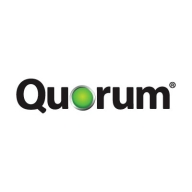

Find out in this report how the two Disaster Recovery (DR) Software solutions compare in terms of features, pricing, service and support, easy of deployment, and ROI.
Azure Site Recovery, while being pricier than some providers, has a sufficient service level to justify costs.
Azure Site Recovery is time-saving, and its features allow us to automate processes and save resources.
Microsoft support could be improved as it rates only a five out of ten, with slow response times and a preference for email over phone communication even in severity B cases.
During a global outage that affected our operations, there was no apology or in-depth follow-up from Microsoft.
Issues frequently require escalation.
I would rate the scalability of Azure Site Recovery as a nine out of ten.
Scalability is provided because they are offering 99.95% availability.
Azure Site Recovery is a very scalable product and service mechanism.
The system did go down a couple of times, which impacted our operations.
I would rate the stability of Azure Site Recovery at eight to nine out of ten.
If their agent version is mismatched and the health status is critical, you will not be able to perform your Azure Site Recovery.
There is room for improvement in the release of patches, such as ensuring they are properly managed to avoid outages.
The flexibility of Azure Site Recovery regarding integration with different IT environments is limited; it is purely an Azure platform service for business continuity, not meant for integration with other services.
The URL for our environments is the same, making it confusing for management when handling different departments with different needs.
A major advantage is that you do not want to pay any more for huge costs to build a DR site.
It was not the expensive part of our costs.
The pricing of Azure Site Recovery is around a four out of ten, being somewhat cost-effective.
It's a little expensive.
The features I find most valuable in Azure Site Recovery include the test failover, which allows us to test our site recovery without bringing down the primary; disaster recovery provides that feature.
In Azure, we can access the services remotely, and we can do DR drills or these other things with minimal cost and resource allocation.
The most valuable features of Azure Site Recovery are its ease of use and speed of recovery.
Quorum OnQ provides an elevated ability to filter on everything from people's location to age to their voting history.


| Company Size | Count |
|---|---|
| Small Business | 8 |
| Midsize Enterprise | 4 |
| Large Enterprise | 14 |
| Company Size | Count |
|---|---|
| Small Business | 19 |
| Large Enterprise | 4 |
Help your business to keep doing business - even during major IT outages. Azure Site Recovery offers ease of deployment, cost effectiveness, and dependability. Deploy replication, failover, and recovery processes through Site Recovery to help keep your applications running during planned and unplanned outages. Site Recovery is a native disaster recovery as a service (DRaaS), and Microsoft been recognized as a leader in DRaaS based on completeness of vision and ability to execute by Gartner in the 2018 Magic Quadrant for Disaster Recovery as a Service.
Quorum onQ is the global leader in 1-click instant recovery, providing full immediate recovery of your critical systems after any storage, system or site failure. It does this by automatically maintaining up-to-date, ready-to-run virtual machine clones of your physical and virtual servers stored on a dedicated appliance – clones that will transparently take over for failed servers within minutes.
We monitor all Disaster Recovery (DR) Software reviews to prevent fraudulent reviews and keep review quality high. We do not post reviews by company employees or direct competitors. We validate each review for authenticity via cross-reference with LinkedIn, and personal follow-up with the reviewer when necessary.